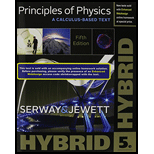
Concept explainers
The emitted particle in the decay process of
Answer to Problem 1OQ
Option (c).
Explanation of Solution
In the decay of radioactive nucleus, the daughter nucleus has the same number of nucleon as the parent nucleon, but the atomic number is changed. Such type of radioactive decay is called beta decay. There are two types of beta decay exist, beta minus decay and beta plus decay. A neutron in the nucleus is transformed in to proton and electron in beta minus decay, and a proton is transformed into a neutron and a positron in beta plus decay.
Here the parent nuclei is
Conclusion:
Since emitted particle is an electron, option (c) is correct.
Emitted particle is an electron. Thus, option (a) is incorrect.
Emitted particle is an electron. Thus, option (b) is incorrect.
Emitted particle is an electron. Thus, option (d) is incorrect.
Emitted particle is an electron. Thus, option (e) is incorrect.
Want to see more full solutions like this?
Chapter 30 Solutions
Principles of Physics: A Calculus-Based Text, Hybrid (with Enhanced WebAssign Printed Access Card)
- A filmmaker wants to achieve an interesting visual effect by filming a scene through a converging lens with a focal length of 50.0 m. The lens is placed betwen the camera and a horse, which canters toward the camera at a constant speed of 7.9 m/s. The camera starts rolling when the horse is 36.0 m from the lens. Find the average speed of the image of the horse (a) during the first 2.0 s after the camera starts rolling and (b) during the following 2.0 s.arrow_forwardAnswer the question (Physics)arrow_forwardsolve smybolically and plug in numbers and solve at the endarrow_forward
- answer the question symbolically until you have to plug in numbers. show all work please.arrow_forwardWhat is the direction of the magnetic force on a NEGATIVE CHARGE that moves as shown in each of the six cases?arrow_forwardHi! I need help with these calculations for part i and part k for a physics Diffraction Lab. We used a slit width 0.4 mm to measure our pattern.arrow_forward
- Examine the data and % error values in Data Table 3 where the angular displacement of the simple pendulum decreased but the mass of the pendulum bob and the length of the pendulum remained constant. Describe whether or not your data shows that the period of the pendulum depends on the angular displacement of the pendulum bob, to within a reasonable percent error.arrow_forwardIn addition to the anyalysis of the graph, show mathematically that the slope of that line is 2π/√g . Using the slope of your line calculate the value of g and compare it to 9.8.arrow_forwardAn object is placed 24.1 cm to the left of a diverging lens (f = -6.51 cm). A concave mirror (f= 14.8 cm) is placed 30.2 cm to the right of the lens to form an image of the first image formed by the lens. Find the final image distance, measured relative to the mirror. (b) Is the final image real or virtual? (c) Is the final image upright or inverted with respect to the original object?arrow_forward
- Concept Simulation 26.4 provides the option of exploring the ray diagram that applies to this problem. The distance between an object and its image formed by a diverging lens is 5.90 cm. The focal length of the lens is -2.60 cm. Find (a) the image distance and (b) the object distance.arrow_forwardPls help ASAParrow_forwardPls help ASAParrow_forward
 Principles of Physics: A Calculus-Based TextPhysicsISBN:9781133104261Author:Raymond A. Serway, John W. JewettPublisher:Cengage Learning
Principles of Physics: A Calculus-Based TextPhysicsISBN:9781133104261Author:Raymond A. Serway, John W. JewettPublisher:Cengage Learning University Physics Volume 3PhysicsISBN:9781938168185Author:William Moebs, Jeff SannyPublisher:OpenStax
University Physics Volume 3PhysicsISBN:9781938168185Author:William Moebs, Jeff SannyPublisher:OpenStax College PhysicsPhysicsISBN:9781938168000Author:Paul Peter Urone, Roger HinrichsPublisher:OpenStax College
College PhysicsPhysicsISBN:9781938168000Author:Paul Peter Urone, Roger HinrichsPublisher:OpenStax College Modern PhysicsPhysicsISBN:9781111794378Author:Raymond A. Serway, Clement J. Moses, Curt A. MoyerPublisher:Cengage Learning
Modern PhysicsPhysicsISBN:9781111794378Author:Raymond A. Serway, Clement J. Moses, Curt A. MoyerPublisher:Cengage Learning Physics for Scientists and Engineers with Modern ...PhysicsISBN:9781337553292Author:Raymond A. Serway, John W. JewettPublisher:Cengage Learning
Physics for Scientists and Engineers with Modern ...PhysicsISBN:9781337553292Author:Raymond A. Serway, John W. JewettPublisher:Cengage Learning Glencoe Physics: Principles and Problems, Student...PhysicsISBN:9780078807213Author:Paul W. ZitzewitzPublisher:Glencoe/McGraw-Hill
Glencoe Physics: Principles and Problems, Student...PhysicsISBN:9780078807213Author:Paul W. ZitzewitzPublisher:Glencoe/McGraw-Hill





